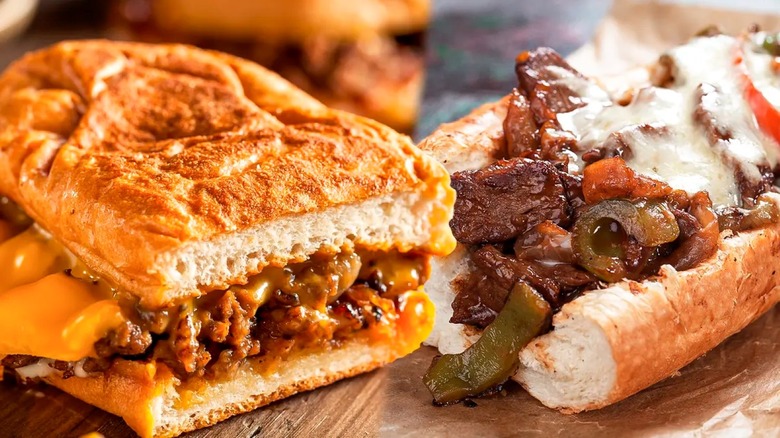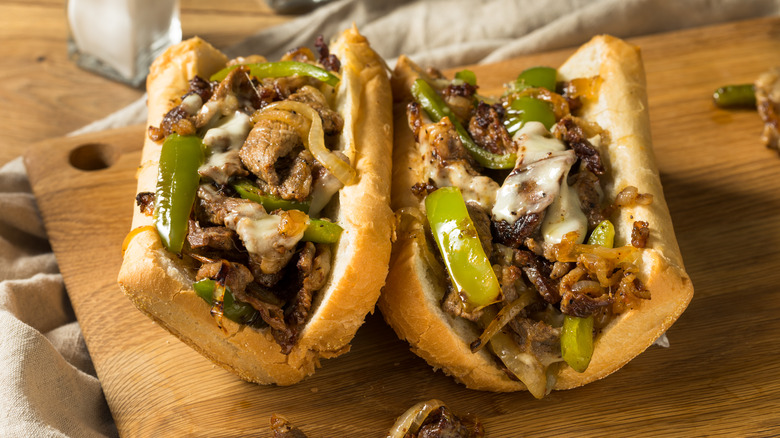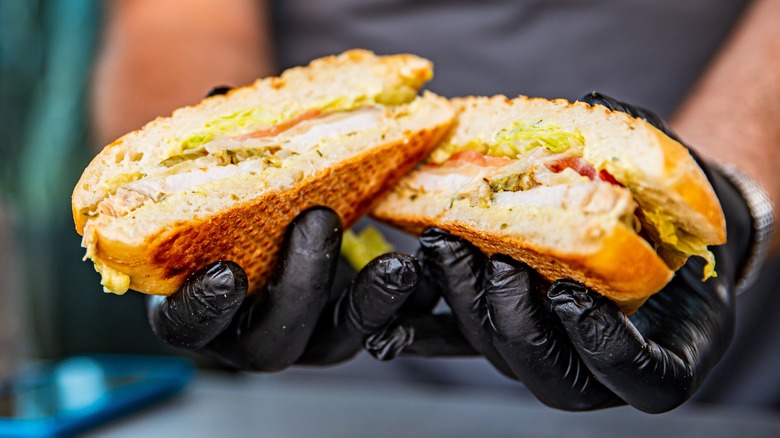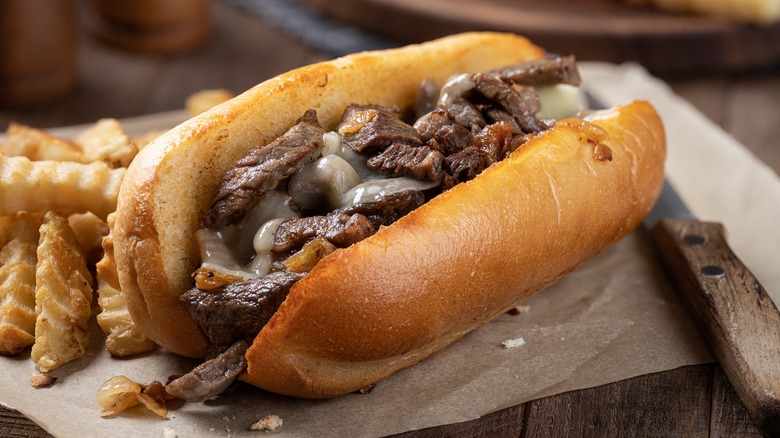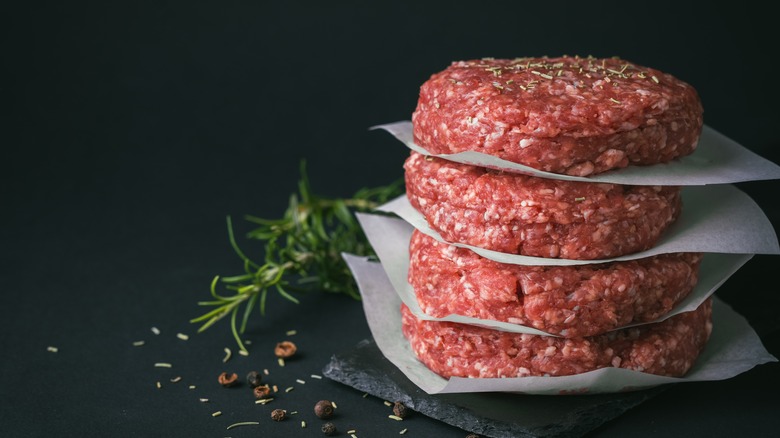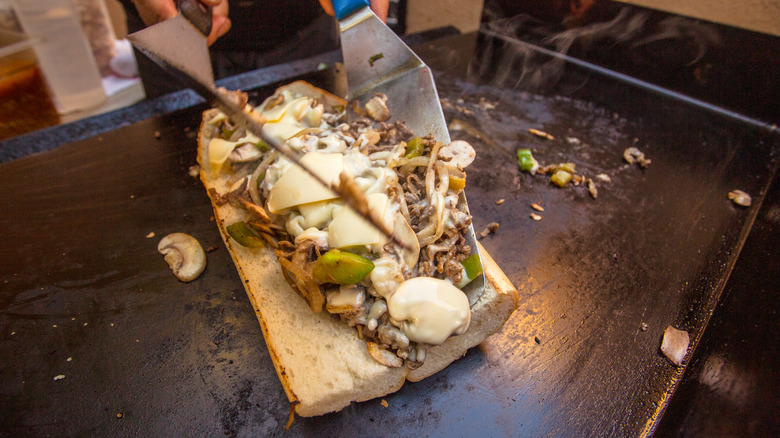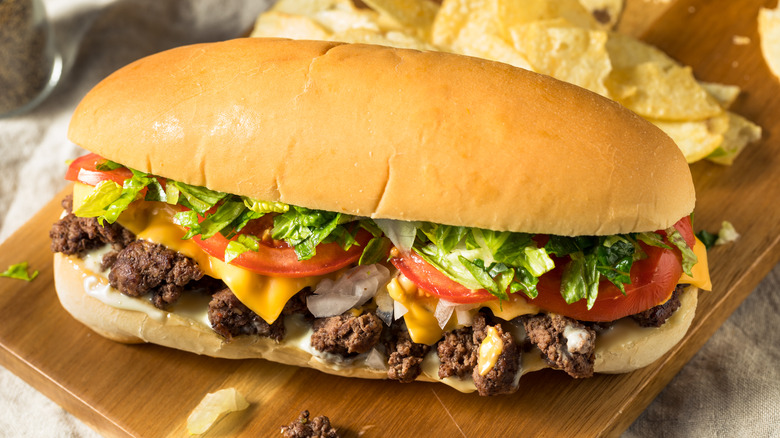Philly Cheesesteak Vs Chopped Cheese: What's The Difference?
Food rivalries between cities are tales as old as time. When it comes to sandwiches in the U.S., it seems like every metropolis has one they call their own — just take Buffalo's beloved beef on weck, for example, or a New Orleans po'boy. But while the differences between those two are pretty stark, there are other popular sandwiches that you might easily confuse. When it comes to the Philly cheesesteak and the chopped cheese, it's understandable if you don't know what makes each one unique right off the bat.
It's true that they come from different cities (Philadelphia and New York City), but there's more to their differences than just the places they call home. Each one features distinct ingredients and is made following a unique method, which leads to a different eating experience and flavor profile. Of course, there are a few things these crave-worthy meals have in common. Both sandwiches are considered subs, both come from the Northeast part of the country, and both will satisfy your savory, umami tastebuds. But let's take a minute to dive further into those differences.
What is a Philly cheesesteak?
There's not a chance you'll feel hungry after downing a Philly cheesesteak. Yet, as hearty as this sandwich is, it involves a pretty simple recipe overall. To whip up a homemade Philly cheesesteak, you'll only need the basics: a hoagie roll, thinly-sliced beef, and melted cheese. Many of the cheesesteaks you see today pile on a few extra delicious ingredients, but as long as you have these three elements, you can consider your creation the real deal.
Unsurprisingly, this recipe first originated in Philadelphia, Pennsylvania as a simple steak sandwich, nearly 100 years ago in the 1930s. The idea was born at a hot dog stand in South Philadelphia, where the two owners and brothers, Pat and Harry Olivieri, whipped up a new sandwich with grilled beef, grilled onions, and a toasted roll. If you're wondering what happened to the cheese, it wasn't added until about a decade later, when a manager at a different location added provolone, thus turning the steak sandwich into an official Philadelphia cheesesteak. You can still find the original Pat's King of Steaks on the corner of 9th and Wharton Street in Philly, where it serves cheesesteaks with a variety of add-ons, hot dogs, a fish cake sandwich, and fries.
What is a chopped cheese?
Compared to the early origins of the Philly cheesesteak, the chopped cheese is a much more recent invention. It's only been around since the 1990s, although the exact year of its creation remains a bit of a mystery. It's also slightly unclear where the first chopped cheese was specifically made — while you may hear rumors of Mount Vernon or Queens, the most common tale is that it originated in Harlem. And within this Manhattan neighborhood, there is one deli that claims the credit for the chopped cheese more than any other: Hajji's Deli (now known as Blue Sky Deli) on 1st Avenue and 110th Street.
Some accounts say Carlos Soto invented it, an employee at Hajji's who passed away in 2014. Others say it was Frankie Frank, who still works there today. Both versions of the story claim that the sandwich was born out of necessity, when the employee in question ran out of hamburger buns and used hero rolls in a pinch. However, it's also possible that Soto collaborated with Yemeni employees to make a different version of the Arabic sandwich dagha yamneeya. Regardless of the exact origins of the chopped cheese, the crucial ingredients to make one remain the same: ground beef, melted cheese, lettuce, tomato, and onion.
Philly cheesesteaks feature thinly sliced beef
As you can probably guess from its name, you'll need steak to make a Philly cheesesteak. You can generally use any type of steak you like; it's how the meat is sliced and cooked that really matters. You'll want thin strips, which help the beef achieve that buttery, melt-in-your mouth quality when you dig into the sandwich. Many shops use a deli slicer, but you can achieve this style of cut at home by freezing your beef for about 20 minutes before taking a sharp knife to it. Make your cuts about ¼-inch thick so they're easy to bite and chew. You don't need much to season your beef before cooking it — salt and pepper will do.
Once the meat is cut, it's typically cooked on a griddle with diced peppers and onions. A simple yellow onion is the go-to here. If you've ever been to Jim's South Street in Philly, which is a hotspot for locals and tourists alike, you've likely witnessed the massive griddle on which they churn out cheesesteak after cheesesteak for a line that goes down the block — but if you're making these at home, you can simply pack everything into the same skillet. To make matters even easier, you can then plop your cheese right on top after the veggies soften, and let everything sizzle until it melts.
Break up a burger patty for a chopped cheese
While chopped cheeses often get confused with Philly cheesesteaks, you can think of the former as closer to a hamburger — if you're looking at just the meat, that is. Instead of the buttery-thin slices of steak in the Philly sandwiches, you'll want to turn to ground beef for a chopped cheese. You can also buy hamburger patties and break them apart when you cook them (hence the "chopped" part of this sandwich); this is how they're typically made in NYC bodegas. You'll want the juiciest stuff possible, so stay away from leaner types of meat at the grocery store.
As with a Philly cheesesteak, you wouldn't typically cook the ground beef for a chopped cheese by itself. You'll start off by throwing diced onions in a skillet and cooking until softened, then you'll add your meat and cook the two together. As with cheesesteaks, keep your seasonings pretty simple here. Salt and pepper are all you really need, although you could also throw in some garlic powder or a dash of Worcestershire sauce. To melt the cheese, throw it on your meat and let it get nice and gooey. Of course, some recipes call for breaking it up (aka chopping it) into the beef too.
Philly cheesesteaks leave plenty of room for customizations
So we know the basics of what goes into a Philly cheesesteak — namely, thinly sliced beef, a hoagie roll, cheese, and sometimes peppers and onions — but there are a few key ways you can customize your sandwich to fit your tastebuds. Although provolone was the first cheese to ever be added to this recipe, folks have been experimenting with Swiss, American, or Velveeta ever since. If you really want to mimic the way plenty of Philadelphians eat their cheesesteaks, grab a jar of Cheez Wiz. This may sound a little off-putting at first, but don't knock it until you try it. Since it doesn't need to melt, you can just drizzle a little on your steak, let it heat up, and scarf it down accordingly.
Other than switching up the cheese, you can customize your Philly cheesesteak by slathering your rolls with garlic butter before toasting them or with mayo after doing so. Scoop some sauteed mushrooms on top, or cover with sliced jalapeños and banana peppers. If you want even more sauciness, eat your sandwich with a side of ketchup or hot sauce. It may not be traditional, but it has certainly been done.
To branch out even more, there are dozens of delicious ways to hack your cheesesteak. Move beyond the sandwich and think lettuce wraps, sloppy joe sliders, and egg rolls with meat, cheese, onions, and peppers.
Chopped cheeses balance fresh and cooked ingredients
While the meat and veggies in a Philly cheesesteak are always cooked, there's a little more room for freshness with a chopped cheese. For this reason, it's more like a cross between a deli sandwich and a burger than a cheesesteak is. After the meat, cheese, and onions are cooked, slide the mixture onto a hero roll along with fresh lettuce (typically iceberg for maximum crunch, although romaine works too) and sliced tomato. Unlike the warm softness of the Philly-based sandwich, you'll get more texture and brightness with a chopped cheese, plus a little acidity from the tomato.
There are a few other elements to customize here, if you so choose. American cheese is a classic for easy melting (and some will say it's the only type you should use), but it's also possible to sub in cheddar, pepper jack, or any fromage you like. As far as condiments go, feel free to go ham with mayo, ketchup, or hot sauce. But no matter how creative you get, make sure you stick to a hero roll and avoid the urge to use a hamburger bun, as this transgression will take your sandwich squarely out of chopped cheese territory.
